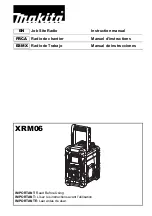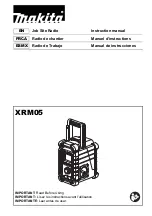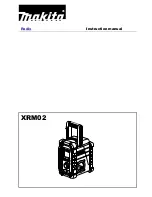
5. Specifications
Channels Available
8 Channels
CTCSS Sub-channel
38 for each Channel
DCS Sub-channel
83 for each channel
Output Power (TX)
0.5 W
Range
Up to 8 Km.
6. Channel Frequency Table
Channel
Frequency (MHz)
Channel
Frequency (MHz)
1 446.00625 5
446.05625
2 446.01875 6
446.06875
3 446.03125 7
446.08125
4 446.04375 8
446.09375
7. Safety
CAUTION
Damaged Antenna
Do not use any FX-400 that has a damaged antenna. If a damaged
antenna comes in contact with the skin, a minor burn may result.
Batteries
All batteries can cause property damage and/or bodily injury such as
burns if conductive material such as jewelry, keys, or beaded chains
touches exposed terminals. The material may complete an electrical
circuit (short circuit) and become quite hot. Exercise care in handling
any charged battery, particularly when placing it inside a pocket,
purse, or other container with metal objects.
WARNING
For Vehicles with an Air Bag
Do not place your FX-400 in the area over an air bag or in the air bag
deployment area. Air bags inflate with great force. If a FX-400 is
placed in the air bag deployment area and the air bag inflates, the
FX-400 may be propelled with great force and cause serious injury to
the occupants of the vehicle.
Potentially Explosive Atmospheres
Turn your FX-400 OFF when in any area with a potentially explosive
atmosphere, unless it is a type especially qualified for such use (for
example, Factory Mutual Approved). Sparks in such areas could
cause an explosion or fire resulting in injury or even death.
Batteries
Do not replace or charge batteries in a potentially explosive
atmosphere. Contact sparking may occur while installing or removing
batteries and cause an explosion.
Blasting Caps and Areas
To avoid possible interference with blasting operations, turn your
FX-400 OFF near electrical blasting caps or in a “blasting area” or in
areas posted: “Turn off the two way radio.” Obey all signs and
instructions.
NOTE:
Areas with potentially explosive atmospheres are often, but not always
clearly marked. They include fueling areas such as below deck on boats; fuel or
chemical transfer or storage facilities; areas where the air contains chemicals or
particles, such as grain, dust, or metal powders; and any other area where you
would normally be advised to turn off your vehicle engine.





























